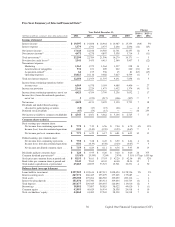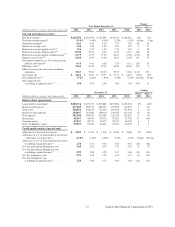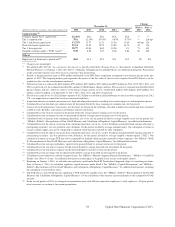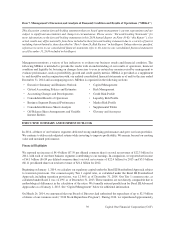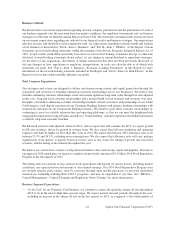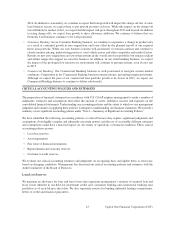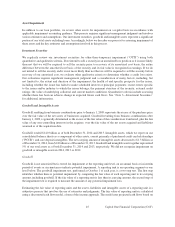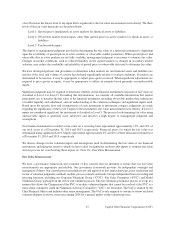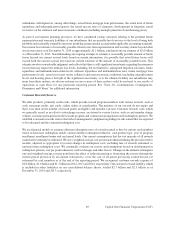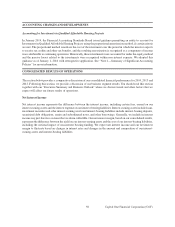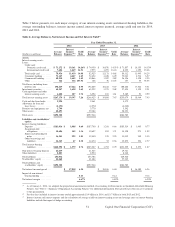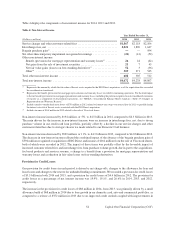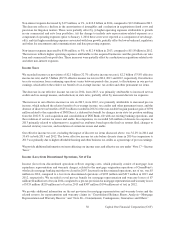Capital One 2014 Annual Report Download - page 68
Download and view the complete annual report
Please find page 68 of the 2014 Capital One annual report below. You can navigate through the pages in the report by either clicking on the pages listed below, or by using the keyword search tool below to find specific information within the annual report.each reporting unit’s internal forecast and use the perpetuity growth method to calculate terminal values. These cash
flows and terminal values are then discounted using discount rates based on our external cost of equity with
adjustments for risk inherent in each reporting unit. Cash flows are adjusted, as necessary, in order to maintain each
reporting unit’s equity capital requirements. Our discounted cash flow analysis requires management to make
judgments about future loan and deposit growth, revenue growth, credit losses, and capital rates. Discount rates
used in 2014 for the reporting units ranged from 8% to 13%. The key inputs into the discounted cash flow analysis
were consistent with market data, where available, indicating that assumptions used were within a reasonable range
of observable market data.
We do not maintain separate balance sheets at the reporting unit level; therefore, we calculate the carrying amounts
of our reporting units using an allocated capital approach based on each reporting unit’s specific regulatory capital,
economic capital requirements, and underlying risks. We compare the total reporting unit carrying amounts to
our total consolidated stockholders’ equity, as discussed further in “Note 7—Goodwill and Intangible Assets,” to
assess the appropriateness of our methodology. If the second step of goodwill impairment testing is required for
a reporting unit, we undertake an extensive effort to build the specific reporting unit’s balance sheet for the test
based on applicable accounting guidance. Based on our analysis, the current fair value exceeded the carrying
amount of all reporting units as of our annual testing date; therefore, the second step of impairment testing was
unnecessary.
As part of the annual goodwill impairment test, we also assessed our market capitalization based on the average market
price relative to the aggregate fair value of our reporting units and determined any excess fair value in our reporting
units at the date of testing. The excess fair value attributed to a reasonable control premium was compared to historical
control premiums seen in the industry.
Intangible Assets
Intangible assets with definitive useful lives are amortized over their estimated lives and evaluated for potential
impairment whenever events or changes in circumstances suggest that an asset’s or asset group’s carrying value may
not be fully recoverable. An impairment loss, generally calculated as the difference between the estimated fair value
and the carrying amount of an asset or asset group, is recognized if the sum of the estimated undiscounted cash flows
relating to the asset or asset group is less than the corresponding carrying value. See “Note 7—Goodwill and Intangible
Assets” for additional information.
Mortgage Servicing Rights
Mortgage servicing rights (“MSR”) are initially recorded at fair value when mortgage loans are sold or securitized in
the secondary market and the right to service these loans is retained for a fee. Subsequently, our consumer MSRs are
carried at fair value on our consolidated balance sheets with changes in fair value recognized in non-interest income.
Our commercial MSRs are subsequently measured under the amortization method and are periodically evaluated for
impairment, which is recognized as a reduction in non-interest income. See “Note 7—Goodwill and Intangible Assets”
and “Note 18—Fair Value Measurement” for additional information.
Fair Value
Fair value is defined as the price that would be received for an asset or paid to transfer a liability in an orderly
transaction between market participants on the measurement date (also referred to as an exit price). The fair value
accounting guidance provides a three-level fair value hierarchy for classifying financial instruments. This hierarchy
is based on the markets in which the assets or liabilities trade and whether the inputs to the valuation techniques used
to measure fair value are observable or unobservable. Fair value measurement of a financial asset or liability is assigned
46 Capital One Financial Corporation (COF)


